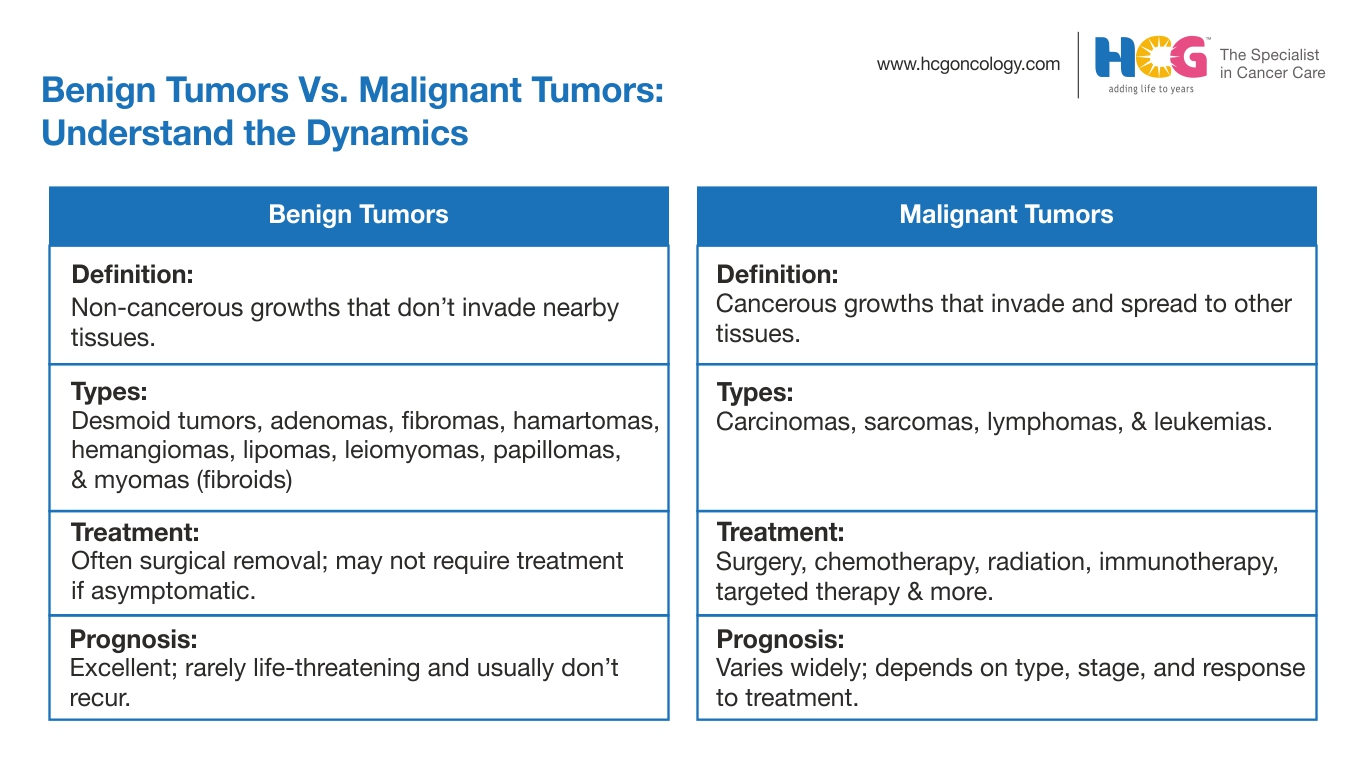
02 Dec, 2025
Feel free to reach out to us.

02 Dec, 2025
Have you ever thought about tumors?
Like, do they always come with symptoms?
Do they all carry the same degree of risk?
Can they be left untreated if they are benign?
How do you know if a brain tumor is benign or malignant?
This blog is your easy-to-understand tour of tumors, where we discuss what tumors are, shed light on benign and malignant tumor differences, and help you know when it's time to see a doctor.
Tumors (neoplasms) are solid masses or lumps of abnormal tissue in the body. Tumors develop when cells multiply faster than usual or do not die as part of their normal cell cycle. They can impact any tissue, gland, or organ, such as the bone, pancreas, lungs, breast, blood, skin, etc.
Tumors can be broadly classified into two types, namely benign tumors (non-malignant tumors) and malignant tumors.
A benign or non-malignant tumor is a mass of abnormal cells that remains localized and does not spread to nearby tissues or other parts of the body.
The biggest difference between benign and malignant tumors is that a benign tumor is non-cancerous, whereas a malignant tumor is cancerous.
Benign, or non-malignant, tumors can have distinct characteristics based on their cellular and structural features. Unlike malignant tumors, benign tumors are less aggressive and do not spread to nearby tissues. The following are the important characteristics of benign tumors:
Non-cancerous tumors have a slow growth rate, and for years, they will have the same size.
Non-malignant tumors have clear, smooth, and even edges. These tumors remain confined to their primary site and do not spread to other parts of the body.
In most cases, benign tumors do not exhibit any symptoms. It’s unlikely to reoccur once surgically removed.
Benign or non-malignant tumors can be classified into several types, depending upon their location of origin. A few examples and types of benign tumors include the following:
Also known as aggressive fibromatosis. They usually affect the connective tissue. They often form in the belly, arms, or legs.
They are benign tumors of glands or organs, such as the pituitary gland, liver, or colon.
Fibromas arise from the fibrous tissues throughout the body.
They are disorganized tissue masses or malformations that are mostly found in the lungs, colon, breast, hypothalamus, etc.
These tumors are made up of blood vessel cells, often found in newborn babies in the form of birthmarks on the head or neck. They can also grow in the brain, liver, or colon. In some cases, hemangiomas may develop in infancy and childhood.
They are fatty growths below the skin, often found in the neck, shoulders, back, or arms. It is one of the most common types of non-malignant tumors.
They form in the smooth muscles of the body. They occur in both men and women of any age group.
They refer to the benign growth of uterine smooth muscles.
These are harmless, abnormal masses that form on the surface of certain tissues and typically grow outward. They can be commonly found on the skin, lips, oral cavity, tongue, and genitals. Direct contact with an infection like the human papillomavirus (HPV) can lead to the development of these tumors.
Generally, benign tumors do not require treatment, especially if they are not causing any health problems. This is also a difference between benign and malignant tumors. However, in certain cases where they grow large, cause discomfort, press on nearby organs, or pose a risk of becoming cancerous, surgical removal might be required.
For example, a large, non-malignant tumor in the digestive system might obstruct the passage of food through the intestine, causing symptoms like abdominal pain, bloating, or bowel movement issues. In such a case, surgery might be necessary to remove the obstruction and alleviate the associated discomfort.
Other examples of benign tumor symptoms include trouble breathing in the case of lung tumors, bleeding in uterine tumors, and seizures or headaches in brain tumors.
Yes, sometimes. Certain types of non-malignant tumors can become cancerous over time and thus need to be closely monitored. They might need surgical removal to prevent this transformation. For example, colon polyps, which are abnormal cell masses, can turn into colon cancer over time.
A malignant tumor is cancerous and can become life-threatening if left untreated.
Malignant tumors exhibit various characteristics, which makes it important for one to receive prompt medical attention when diagnosed with a malignant tumor. The following are some of the important characteristic features of malignant tumors:
Malignant tumors often exhibit uncontrolled cell division. This rapid growth will lead to tumor formation.
Cancerous tumors can grow into and infiltrate surrounding healthy tissues.
The ability to spread to other parts of the body is one of the defining features of malignant tumors, and it is also the difference between benign and malignant tumors. The rapidly dividing cancerous cells enter the bloodstream or lymphatic system, which allows them to travel to different parts of the body, where they form tumors.
Malignant tumors are invasive and can have serious health consequences if left untreated. These tumors can interfere with the normal functioning of the organs, leading to multiple health complications.
Malignant tumor examples include the following.
They originate in the epithelial tissues, such as the skin, lungs, or glands. Carcinomas account for 90% of malignant tumor cases.
They form in connective tissues like bone, muscle, or fat. They are common in young adults.
Also known as blood cancers, they are malignant tumors affecting blood-forming tissues, characterized by abnormal blood cell production.
They occur in the lymphatic system, affecting lymph nodes and lymphoid tissues commonly in the neck, underarm, or groin area.

The biggest difference between benign and malignant tumors is the former’s ability to remain localized and the latter’s ability to spread to different parts of the body. However, there are other differences too. Let's compare benign tumors vs. malignant tumors side by side by listing their unique traits in an easy-to-understand table format.
| FEATURES | BENIGN (NON-MALIGNANT TUMORS) | MALIGNANT TUMORS |
|---|---|---|
| CANCEROUS OR NOT | Non-cancerous | Cancerous |
| GROWTH PATTERN BOUNDARIES, SPEED | Grows slowly and has defined boundaries | Rapid growth, undefined boundaries |
| SPREAD AREA | Does not spread | Can spread to other body parts |
| SHAPE | Regular surface, capsulated, not attached to deep structures | Irregular surface, non-capsulated, attached to deep structures |
| EFFECT ON SURROUNDING STRUCTURES | Non-invasive | Invasive |
| POSSIBILITY OF REPEAT | No recurrence after surgery | Can reoccur after surgery |
| LIFE-THREATENING OR NOT | No | Yes |
| TREATMENT | May or may not be required | Must |
Diagnosis plays a pivotal role in distinguishing between benign and malignant tumors. The tumor diagnosis is also necessary for the doctors to plan the right intervention.
Your doctor will examine you physically and check for unusual lumps or changes in your body.
Imaging tests include X-rays, ultrasounds, computed tomography (CT) scans, and magnetic resonance imaging (MRI) scans, which help visualize and identify the tumor's location and size.
X-rays are useful for detecting bone tumors or abnormalities in the chest, like lung masses or breast calcifications.
An ultrasound scan can help visualize soft tissue tumors and can guide biopsies, especially for breast or abdominal tumors.
This scan offers detailed cross-sectional images and is effective in identifying tumors in the brain, chest, abdomen, and pelvis.
An MRI scan is particularly valuable for soft tissue imaging to examine brain tumors, spinal cord tumors, and tumors in organs like the liver or prostate.
This involves taking a small sample of the tumor for examination under a microscope, aiding in determining whether the tumor is benign or malignant.
Your doctor may recommend ‘watchful waiting’ and keep an eye on the tumor's growth and behavior through regular check-ups and imaging tests.
Your doctor may consider removing the benign tumor through surgery if it is associated with symptoms or may lead to health complications in the future. Doctors may use open or minimally invasive approaches for tumor surgery.
Treatment generally depends on the type of cancer, its stage, the exact location, the patient’s age, and the overall health condition of the patient.
The tumor can be removed by surgery. Tumor surgery is usually the first line of treatment for tumors, and it may be combined with other modes of treatment.
Cancer medications, or chemotherapy, are prescribed to destroy cancer cells and prevent metastasis. Chemotherapy drugs may be administered orally, topically, or intravenously.
Radiation therapy involves the use of powerful radiation beams to kill cancer cells or shrink tumors.
Targeted therapy may be used to specifically target cancer cells while minimizing damage to healthy cells. The drugs administered under targeted therapy identify specific molecules and cellular pathways associated with cancer cells and target them to control the growth of cancer cells.
Immunotherapy works by boosting the body's immune system to fight cancer cells effectively.
Studies have shown that adopting a healthy lifestyle, sun protection, and vaccinations may reduce the risk of developing some types of tumors.
However, it is important to note that these measures only reduce the risk of cancer formation and do not prevent it. This is because factors like genetics and environmental exposures also play a role in tumor development.
Regular screenings and checkups are thus advised to aid in early detection and treatment.
At HCG, we know how tough it can be to face the diagnosis of malignant tumors. We have a robust team of cancer specialists who excel at diagnosing and treating different types of cancer. We have the latest technology for diagnosis and offer advanced treatment options for a wide range of malignant tumors. We'll work closely with you to create a personalized care plan that fits your needs. Beyond being a cancer hospital, we are committed to being your health partner, ensuring we understand and address all your healthcare needs.